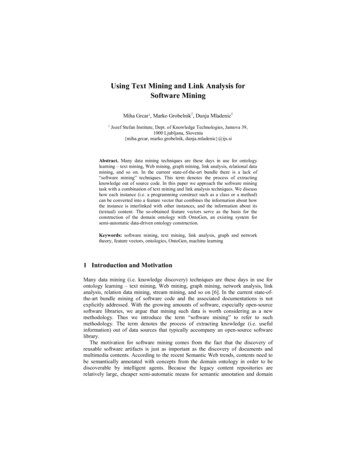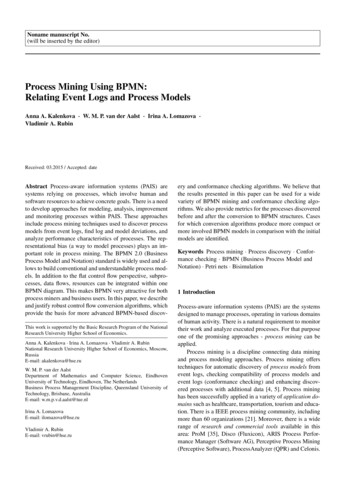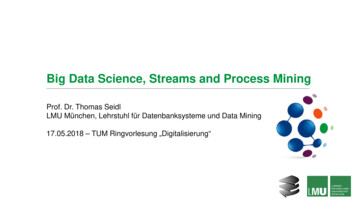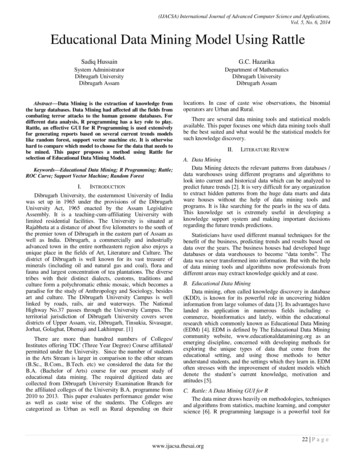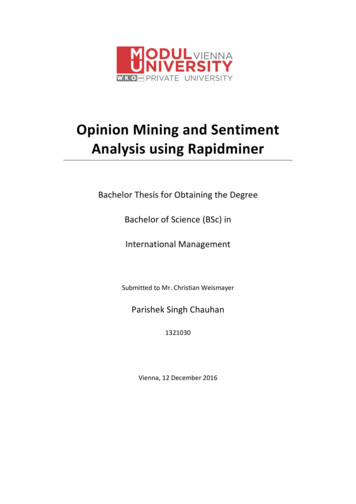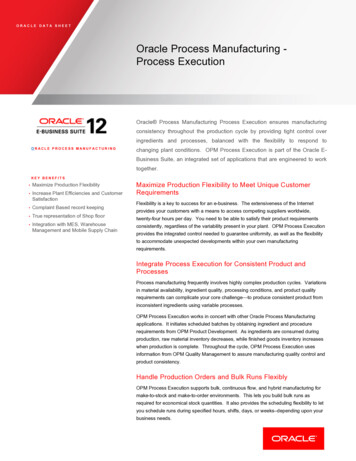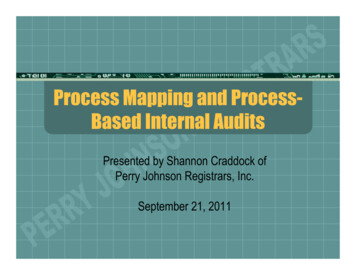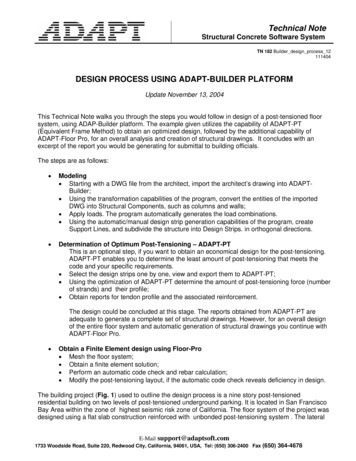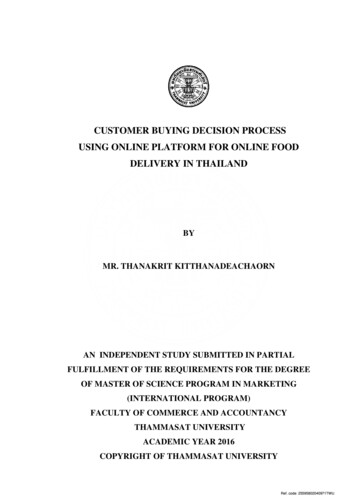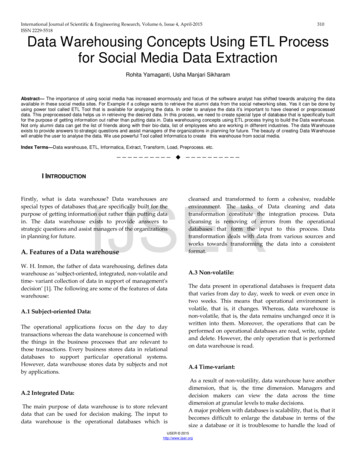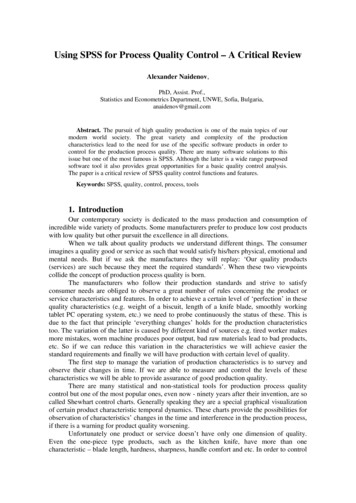
Transcription
DATA ANALYSIS AND INTELLECTUAL SYSTEMSUSING PROCESS MINING FOR THE ANALYSISOF AN E-TRADE SYSTEM: A CASE STUDYAlexey MITSYUKAnalyst, International Laboratory of Process-Aware information Systems (PAIS Lab.),National Research University Higher School of EconomicsAddress: 20, Myasnitskaya str., Moscow, 101000, Russian FederationE-mail: amitsyuk@hse.ruAnna KALENKOVAResearch Fellow, International Laboratory of Process-Awareinformation Systems (PAIS Lab.), National Research UniversityHigher School of EconomicsAddress: 20, Myasnitskaya str., Moscow, 101000, Russian FederationE-mail: akalenkova@hse.ruSergey SHERSHAKOVResearch Fellow, International Laboratory of Process-Aware informationSystems (PAIS Lab.), National Research University Higher School of EconomicsAddress: 20, Myasnitskaya str., Moscow, 101000, Russian FederationE-mail: sshershakov@hse.ruWil van der AALSTAcademic Supervisor, International Laboratory of Process-Aware information Systems(PAIS Lab.), National Research University Higher School of Economics;Full Professor, Department of Mathematics & Computer Science,Eindhoven University of Technology, Eindhoven, The NetherlandsAddress: P.O. Box 513, NL-5600 MB, Eindhoven, The NetherlandsE-mail: w.m.p.v.d.aalst@tue.nlE-trade systems are widely used to automate sales processes. Inefficiencies and bottlenecks in the sales processes leadto business losses. Conventional approaches to identifying problems require much time and result in subjective conclusions.This paper proposes an approach for the analysis of e-trade system processes based on the application of process miningtechniques. Process mining aims to discover, analyze, repair and improve real business processes on the basis of behaviorof an information system recorded in an event log. Using process mining techniques, we have analyzed process runningin an online ticket booking information system. This work has shown that process mining can give insight into the e-tradeprocesses and can produce information for their improvement. The case study carried out allows formulating appropriaterecommendations. The article also presents the real outcome of using process mining techniques. We have generalized theapplied approach and showed how it could be used to the investigation of a wide spectrum of e-trade information systems.During the case study we mostly used a software framework named ProM, which includes a substantial number of plugins implementing process mining methods. Using software for automatic process analysis and discovery, one should becareful with the interpretation of particular methods’ output. Pitfalls and difficulties of applying process mining techniquesto the logs of e-trade systems have also been shown.Key words: process mining, process analysis, data analysis, e-trade system.BUSINESS INFORMATICS 3(29)–201415
DATA ANALYSIS AND INTELLECTUAL SYSTEMS1. IntroductionProcess mining is a new and fast-growing researcharea in the field of Business Process Management.The idea of process mining is to discover, analyzeand improve processes by extracting knowledge fromreal-life event logs of an information system [1, 2]. Suchevent logs are usually produced by most modern information systems. There are only two requirements for processmining: (1) there is a notion of a process, and (2) there isan event log that keeps recorded behavior of a process in astructured form. The event log has to contain informationabout process steps (events) together with timestampsand, perhaps, additional information (actors, resources).If both of these requirements are met, it is possible to apply a wide range of process mining techniques, including those implemented in ProM Framework [3]. Processmining includes (1) process discovery, (2) conformancechecking, and (3) process enhancement [1]. Discoveryaims to learn a process model from an event log, i.e. toderive a process model from observed behavior recordedin event log. Conformance checking answers the questionwhether the modeled behavior matches the observed behavior. Model enhancement comprises model improvement, extension, and optimization based on informationobtained from event logs.This paper describes an application of process miningto the analysis of e-trade system processes. This analysisis crucial for finding process bottlenecks and improvingan information system. E-trade systems are widespread.Typically, a today’s e-trade system consists of a serverthat processes the requests and a set of client softwareapplications or a web-based client interface generatingrequests. When one wants to buy something (goods orservices), they use a web site (in the open system case)or a client application (in the case of internal corporative system) to browse the list of available offers, thenthey form a request and send it to the server. An application at the server site receives this request and processesit in a number of ways using a particular process scheme.Eventually, a staff member should be involved in approving the request or preparing a ready supply.The analysis of business process models, like the onesconsidered here, is far from trivial. In most cases, information systems have a rather complex structure, and involve a lot of services and people. Frequently, there is noexplicit process model describing the system behavior.Developers and analysts often rely on an implicit modelof the process, which is not well correlated with reality,i.e., real-life behavior is very different. When somethinggoes wrong in such a process, it is a sophisticated task to16get insight into the problem and solve it. Since e-tradeinformation systems generate event logs, process miningtechniques can be used for analysis and improvementof such processes. Moreover, the recording of all tradeoperations is typically regulated by law. Using processmining methods, one can investigate the functioning ofan information system, obtain models of real processes,analyze these models, locate inefficiencies, and proposeimprovements.The paper presents a real case study involving an online e-trade system that was analyzed using process mining techniques.Process mining has been applied in many other domains. For example, several papers have been publishedon process mining of healthcare processes, cf. the papersby Mans, van der Aalst et al. [5], Kirchner, Herzberg, etal. [6], and other works [7, 8, 9]. Another interesting application for process mining techniques is business process auditing [10, 11, 12, 13, 14]. There are also papersthat consider using process mining in insurance [15].Even maritime vessel behavior has been analyzed usingprocess mining [16]. Process mining is a new rapidly developing area, thus applying process mining in real-lifesituations is of particular interest both for practice andfurther research.Process mining uses many heuristics, and the directapplication of process mining methods without any preprocessing usually is not helpful. The results of applyingprocess mining strongly depend on the problem definition and questions asked. One has to be very precise withconditions and software settings to obtain relevant outcome (see [18]). Selection of appropriate techniques according to the subject area is an important preliminarystep of analysis. Note that while dealing with a specificproblem, one has not only to play with the parametersbut also to extend existing methods.The rest of the paper is organized as follows. Section2 contains a general description of the problem. Section3 presents analysis of the studied online e-trade information system. Finally, section 4 gives some conclusionsand further research directions.2. Online ticketbooking information systemIn this paper we consider a case study aimed at finding inefficiencies in a typical e-trade information systemprocess that deals with booking travel tickets, and at proposing changes that would possibly lead to higher turnovers. To achieve these goals, various data analysis andprocess mining techniques were used.BUSINESS INFORMATICS 3(29)–2014
DATA ANALYSIS AND INTELLECTUAL SYSTEMSThe system is a portal designed to provide ticket booking services. It is a website that allows the users to searchtickets according to a number of criteria (destinationcity, date, carrier, class of service, etc.). The resultingtickets are offered to the user. After booking, the usercan purchase the reserved ticket by paying with a creditcard or in cash. There is also an additional service whenpurchasing tickets: the user is advised to buy travel insurance. The server processes the requests and stores all thedata, including event logs of the system behavior. Thus,we can apply process mining techniques.Table 2.EventsIDentry serial numberPAGE IDID of a page on which specific actions wereperformed; ID field from Table 1OBJECTpage structure object that the client submitted toan actionWINDOWwindowPAYMETHODpayment typeCONFIRM SUBMIT«book» buttonACCEPTacceptance of the fare conditionsUsually the average number of purchases per uniquesite visitor is used to evaluate the effectiveness of thiskind of portal. The metric value for the portal is lower than the average value for similar projects in Russia,according to the information received from experts ofthe portal owner company. Thus, there are problems orbottlenecks in portal functioning. The portal owner hadthe feeling that potential clients left the travel portal after starting browsing and filling the forms without completing purchase of a ticket. The goal was to confirm orto refute this idea, and, in the latter case, to answer thequestion why this happens.SURNAMEsurnameNAMEnameDOCNUMBERdocument numberBIRTHDAYdate of birthEXIST DOCEXPIREexpirationDOCEXPIREvalid untilFARE DETAILlink to information about the fareC EMAILe-mailEvent data gathered by the portal were used as inputfor this study. Initially, a period of one month was analyzed. Two tables provided by the portal and containinginformation about its functioning were used as input forcreating an event log. The main fields of these tables arelisted below (Tab. 1, Tab. 2). Each event in the log relates to an activity (a step in a process) and belongs to aprocess instance (a case). Table 1 contains cases, and Table 2 is filled with types of events recorded by the server.INSURED PERSONadding insuranceACTIONaction on an object; possible options:LOAD, UNLOAD, CLICK, CHECK, UNCHECK, FILL,SELECT, CLEARFF CARD NUMBER ADDlink for adding a frequent flyer card numberFF CARD NUMBERfrequent flyer card numberC PHONE NUMBERcell phoneTable 1.The two tables containing information about theportal functioning were considered as an event log. Inorder to apply process mining techniques, it was necessary to have a single log file in a specific strictly formalized format [19]. Thus, the tables were merged toa single file by using the unique field identifiers and«PAGE ID» field.At the start of this research, the owner of the portalhad no strictly formalized process model for the system,only a general description and a vague scheme of how itshould function. Therefore, it was necessary to design amodel. One preliminary step was needed before: to obtain and preprocess the event log.The preprocessing of the event log was performedusing MySQL RDBMS [20], as well as ProM framework with additional software tools [19]. First of all, itwas necessary to identify those fields which constituteevents (i.e., event class identifiers in the informationsystem). The combination of fields «OBJECT» «ACTION» was chosen, as it identifies all the unique useractions. Taken separately, these fields do not completely describe an event in the portal information system.The user may perform different actions on the sameobject («click», «clear» and «fill»), at the same time thesame action can be performed with regard to differentobjects (e.g., «pressing the left mouse button»). However, the pair of these fields uniquely characterizes anevent (for example, «pressing the left mouse button on«submit» button»).CasesIDrecord serial number (page ID)SESSION IDclient session IDACTION COUNTnumber of actions on a pageORDER STATUSstatus of an order for which the user entered data3. Analysisof the system behaviorBUSINESS INFORMATICS 3(29)–201417
DATA ANALYSIS AND INTELLECTUAL SYSTEMSThe event log was filtered in various ways before being analyzed. The significant and insignificant parts wereidentified. The timestamps of the log events were analyzed. It was important to filter out all the actions of theportal administration team, which was done using the selection based on user IP addresses. In the next chapter wewill show statistical characteristics of the booking process.traces out of all launched (16818) users tried to submit afilled form to the server. Other traces can be consideredunfortunate for the seller. Several traces without completion are the traces with a cut-off, but not all of them.This means there are problems with stability of the website. Users have problems during filling and submittingforms.3.1. Preliminary analysisThe five most common classes of events in the log after removing «WINDOW LOAD» and «WINDOW UNLOAD» events are shown in Fig. 2.We analyzed an event log containing the records of theportal operation over a short period of time. As an eventclassifier, the pair of primary keys «ACTION» and «OBJECT» was chosen. «SESSION ID» field was selected asa trace classifier. The total number of events in the logwas 84760 (50 different classes of events), and the totalnumber of unique traces was 16818.The ten types of events that are the most frequently represented in the log are shown in Fig. 1. It can beseen, that about 40% of all events available in the log areevents of page loading and unloading. Importantly, thenumber of unloading events does not match that of pageloadings. This effect is caused by cutting off the eventsthat are outside the considered timeframe.One can see that for 7564 traces (i.e., about a half), users attempted to select a payment method. Only in 4909The distribution of final events in the user traces isnoteworthy. Fig. 3 shows the statistics for the five mostfrequent final trace events. One can see that only halfof the sessions (49.85 %) end with attempts to submitdata to the server. Approximately 17 % of customers finalize browsing the site after pressing «select a paymentmethod» button («PAYMETHOD CLICK» action),which indicates the inadequacy of the payment optionsprovided.Another common event occurring prior to unloadingthe page is the event of displaying the fare conditions(«FARE DETAIL CLICK» action). In 367 cases, thevisitors left the portal after viewing the fare. This valueis not too large (it is obvious that some users will not besatisfied with the proposed fares).Fig. 1. The most frequent events in the logFig. 2. The five most frequently occurring events after removing the page loading and unloading events18BUSINESS INFORMATICS 3(29)–2014
DATA ANALYSIS AND INTELLECTUAL SYSTEMSFig. 3. The final eventsFig. 4. Characteristics of the event log after removing the loading and unloading eventsThe most of traces contain two exact events. Theseare traces consisting of «WINDOW LOAD» and «WINDOW UNLOAD» events. It takes from 30 seconds to 1hour between the two events. Such traces must be associated with the users who only browse various offers, aswell as with the web crawlers, which, of course, have noeffect on booking.Fig. 4 shows characteristics of the event log after removing the page loading and unloading events (and correspondingly the traces consisting only of opening andclosing the portal page). Thus, the real average numberof events in a trace is 8 (6 plus the two events for openingand closing of the page). Below we consider the filteredevent log consisting of 52000 rather than 84000 events.By using process mining it is possible to identify factors affecting the user’s desire to use portal’s services andbuy a ticket on it.Fig. 5. Typical traces (sequences of activities)BUSINESS INFORMATICS 3(29)–2014One of the potentially problematic areas of the websiteis its reliability. When working with the portal event log,the following fact was identified: many users repeatedly(up to 9 times, Fig. 5) produce the action of submittinga completed form to the server, which is designated by«CONFIRM SUBMIT CLICK» event (such behaviorwas observed in more than a half of the cases). This behavior indicates a problem with bandwidth and connection efficiency of the channel between the user interfaceand the portal server/database. As a result of such purelytechnological problems, many users may leave the attempt to submit data to the server and therefore refuse tobuy tickets using the portal.3.2. Fuzzy modelof the ticket booking processThe general scheme of users’ ccess to the portal canbe represented by a fuzzy model. The fuzzy model is adirected graph, its vertices corresponding to the events(i.e., user actions). The arcs denote the time dependencies. If some user action is preceded by (not necessarilyimmediately) another action, this dependence is denoted in the graph by an arc from the preceding action tothe following one. To derive a fuzzy model Fuzzy MinerPlugin for ProM framework was used [3].The model contains information about the frequency of events occurrence and other characteristics. Fig.6 shows an example of diagram fragment where «SUR-19
DATA ANALYSIS AND INTELLECTUAL SYSTEMSNAME FILL» and «WINDOW LOAD» vertices correspond to the actions of completing «Name» field andloading the page, respectively. For each node a relativefrequency of occurrence of an event in the log is shown.For the arcs a relative frequency of existence of a temporal relationship between two events in the log was derived. The indicated «correlation» (see Fig. 6) is calculated on the basis of event name similarity and matchingof common attribute OW-LOADComplete1,0000,1910,331Fig. 6. A fragment of the fuzzy model of the complete event logThe fuzzy model contains only the elements with numerical characteristics above a certain threshold value.This makes the model more compact and allows considering only significant elements and connections whichdefine patterns in the analyzed plete1,000Cluster 546 er 569 elements0,029Fig. 7. The simplified fuzzy model of the complete event logThe fuzzy model (Fig. 7), as supported by a ProMplug-in, helps to group the sets of events into clustersand to hide excessive details.On the basis to the generated models, we can concludethat among the most common user actions, that precede(but not necessarily immediately) the closing of the portal page, are the actions of opening the portal page, selecting a method of payment and confirming the booking of tickets.20By filtering out the traces containing accomplishedorders from the log (i.e., «ORDER STATUS» attributevalue is set to «finalized»), we can make assumptionsabout the reasons for users to leave the portal. On a fragment from the detailed fuzzy model (Fig. 8) we can seethat the relative frequency of the identified relation between the actions of closing the portal page and choosing a payment method is calculated as 0.321.However, to obtain this and other dependencies moreexplicitly it is necessary to filter out (sanitize) the log byremoving all traces containing only two events of opening and closing the portal page.A fragment of the fuzzy model built for the traces thatcontain more than two events is presented in Fig. 9.Cluster 6531 elements0,055WINDOWUNIOADComplete0,888Fig. 8. Dependence of closing the portal page on viewinginformation about payment methodsThis fuzzy model allows us to conclude that for thegiven event log in 36.7 % of cases the closing of the portal page (not necessarily immediately) is preceded by areservation confirmation, in 32 % of cases – by viewingthe
Using software for automatic process analysis and discovery, one should be careful with the interpretation of particular methods’ output.
